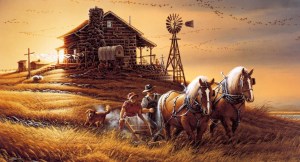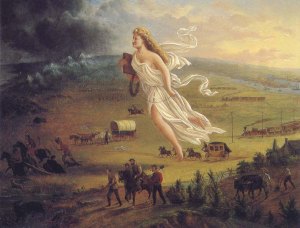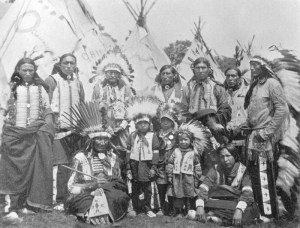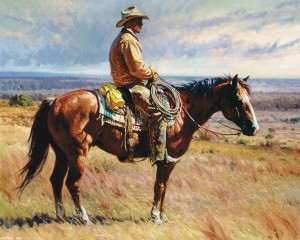I realized that on this blog, I haven’t yet written much on the topics of history and have mostly been focused on current events with international or economic implementations, therefore, I have decided today to write about topics of history which interests me. As the first part of a series on history, let’s examine the story of the American West.
The expansion of the United States is a complex process that took place over the course of centuries and left behind a legacy that is still being felt today. The process of the “conquest” of the West involves the interactions of not only different groups of people but also different ideas that contrasts and clashes with each other often violently. In forming a true understanding of the West, we must look at three things in particular, the power of ideologies in westward expansion, the role of commercial/practical interests, and the way the whites interacted with the natives (in many ways defined by the first two ideas).
The traditional stories of the West is a story involving the ideals of Enlightenment and Liberal Humanism, the idea that all mankind has certain inalienable rights and a belief that all humans, by using logic and reasoning, can bring about improvements to society. Central to Enlightenment thinking is the concept of Progress; which in the case of the American West, is the ideas of “Manifest Destiny”, the idea that it is a God-ordained right of the American people to populate the continent.
However, this idea of progress is inherently problematic, as the Western notion of progress is not applicable everywhere, and it is most certainly hard to define. What is defined as Progress – with a capital “P” – is all political, and often progress is a way for people to legitimize the actions they have undertaken. What is progress for the Whites in the early nineteenth century is certainly not the same as those for the Indians who have been living on the land for hundreds or thousands of years. However, for the Whites, the Indians have made no progress. In many cases, the land has not been modified in any noticeable ways, especially among the Plain Indians (such as the Lakota Sioux). To White Americans, Progress is defined as having farming as well as industry as the backbones of the economy, and not in a nomadic lifestyle. However, for the natives of the Plains, the land is being used productively, as they are entirely self-sufficient in using the land and its products for their needs. Here we see the contrasting notion of what is Progress and what is being productive, with white farmers and industrialists pushing toward the West for what they believed was being productive, with Natives viewed as counterproductive forces that inhibited the full exploitation of the West and must be removed in order to fully exploit the area for the benefit of all.
This perceived lack of progress is also used as a justification for the taking of the land from the Natives. An example would be the taking of the land from the Plains Indians. Since the introduction of the horse, the tribes of the Northern plains have been living in a largely nomadic lifestyle. In their case, it is the view of many Americans that by bringing farming and large-scale mining of the Black Hills of South Dakota, the land can be used productively.
Enlightenment ideologies also serves as a guiding force for the expansion of the country, and not merely for its justification. For example, the one of the central argument for the early expansion of the United States is the need for the country to find agricultural land for its expanding population. This is part of the Jeffersonian ideal, as the yeoman farmer is believed to be the very foundation of the democracy and stability, and best serve the interests of the country by being tied to a stable home and resources; or as John Adams stated, “Power always follows property”. However, this assumes that the land is empty for the taking, which it is not. Hundreds of tribes lived here and some have been farming for many years, such as the Five Civilized Tribes of the Southeast, who have even adopted many aspects of US laws. The Whites wanted the land, but to simply rob the land of its rightful owners is in contrast to Enlightenment ideals of equality. Therefore, in order to justify this taking of the land, Whites interpreted theses rights of the individual as belonging to White males only, and the rights of the natives were largely ignored, and that a Native no matter how educated he becomes or how he adapts western culture will never be fully integrated. Here, we see a double standard: where whites are superior to natives and the forces of western civilization is stronger than the forces of native ideals, and we assume that these relationships will hold true in any situation. This is a way for certain groups to systematically deprive the Natives of their rights and their claims on the land and to clear them unto reservations where they will be truly “civilized”.
The Jeffersonian ideals of the early 19th century did not last very long, already, with Jackson we see a trend of having governmental powers serving the interests of industrial and corporate needs rather than that of small independent parties. For instance, the clearing of the Cherokee Indians is in large part due to the discovery of gold in the region, and this is a pattern that will repeat itself over and over again in the course of the 19th century, in the discovery of silver in Nevada and Colorado, and in the discovery of gold in the Black Hills of South Dakota. Every time, a need for natural resources arises, the natives that controlled the land would often be the first ones to go, to be moved to a barren reservation. Indeed, in many cases, what motivated Westward expansion is not so much as a commitment to ideals as desire for money and other natural resources.
In looking at the West, we must understand how the Nature of the West appears to Americans from the colonial era into the 19th century. While the borders of frontier is being constantly pushed westward, there is the constant idea that the wilderness beyond the frontier is filled with danger. The West is perceived as a wild land that needs to be tamed. To many White Americans growing up with the Christian tradition, the Wilderness is a hostile place where the devil resides, and it takes the forces of civilization, of mastering nature to turn the West into a civilized place. To different people, the West can be personified either as a seductive female waiting to entrap the civilized man if he is not careful, or a virgin waiting for civilization to come. In any case, we see Nature being personified as a female as contrasted with the largely male explorers and later miners and other workers. Again, this is an example of hierarchal dualism, where the female (perceived as weak but potentially dangerous) as being subordinate and subjected to the forces of the male dominated civilization of the Eastern US. For the Indians that have always call the “wilderness” home, the construction of the pre-settled West as a wild uncivilized land is certainly inaccurate. Here we see the social construction of nature, where White civilization imposes its view of what is Nature and what is wilderness on the environment, with little regard to what the Native inhabitants of the land believed in.
With connection to the nature and exploration, a uniquely American concept was also introduced in the 19th century, the concept of “rugged individualism”.  The myth of this individualism states that the American Protestant man and his family overcame great hardships to venture West and establish for himself a home in the wilderness, where he, again, through his hard works and resourcefulness, overcame all sorts of difficulties and prospered. In every stage of his home-building, he is always independent of the society around him and is always. This is also part of the grand narrative of the West, where individualism (as exemplified by cowboys, rangers, and sheriffs as well homesteaders) is praised.
The myth of this individualism states that the American Protestant man and his family overcame great hardships to venture West and establish for himself a home in the wilderness, where he, again, through his hard works and resourcefulness, overcame all sorts of difficulties and prospered. In every stage of his home-building, he is always independent of the society around him and is always. This is also part of the grand narrative of the West, where individualism (as exemplified by cowboys, rangers, and sheriffs as well homesteaders) is praised.
However, nothing could be further from the truths. One woman who moved to Nebraska in the 1880s, commented that everyone seems to “live out of cans”. This demonstrates an intimate connection to the East, where manufacturing and canning occurs. Indeed, while the people is living in the West, the people have not severed from their roots. Besides relying on the East for manufacturing support, the West is also reliant on the East for market and for exports to Europe and the rest of the world. The economy of the West is based on commodities: Gold, minerals, cattle, crops, etc, which cannot be consumed in the West alone. The West is not self-sufficient and has never been so. To argue the opposite would run contrary to historical facts.
So the next time you hear or read about the American West, do not merely think of gold rushes, cowboys, individual heroisms, or other things we normally associate with the region. Instead, remember that the west is a part of the larger historical narrative of America, something that is far more complicated than it first seemed to our mind.
